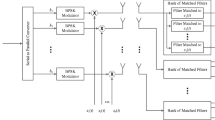Abstract
Digital Terrestrial Television (DTV) has been widely deployed globally for more than a decade. The transmitter identification (Tx-ID) technique specified in modern DTV standards becomes important today as the number of DTV transmitters grows with the expanded coverage area. In the ATSC standards, Kasami sequences, a crucial class of pseudo random sequences, are considered as feasible Tx-ID sequences because they possess several favorable properties leading to nearly Dirac-delta autocorrelation/cross-correlation functions and large sequence capacities. It is well known that the interference-pluse-noise level (INL) or signal-to-interferenec-plus-noise ratio (SINR) plays a very important role in the Tx-ID system performance. Nontheless, such a crucial factor has been evaluated only in the statistical average due to the difficulty of characterizing the exact pertinent probabilitistic analysis. In this work, we combat the aforementioned difficulty by applying a probability-density approximation method to statistically characterize random variables like INL and SINR. With the exact probability density functions of INL and SINR, we can analyze the detailed statistical characteristics of numerous Tx-ID related parameters, including Tx-ID capacity and reception quality in terms of SINR. Extensive numerical experiments are also undertaken to justify the effectiveness of our proposed new analysis and explore detailed quantitative insight for critical Tx-ID system parameters and performance metrics.









Similar content being viewed by others
Notes
Note that “gcd” specifies greatest common divisor.
References
Hong, H., Xu, Y., Wu, Y., He, D., Gao, N., & Zhang, W. (2021). Backward compatible low-complexity demapping algorithms for two-dimensional non-uniform constellations in ATSC 3.0. IEEE Transactions on Broadcasting, 67(1), 46–55.
Beigi, N. A. K., & Soleymani, M. R. (2021). A novel coordinated multipoint scheme with zero guard interval for ATSC 3.0 single frequency networks, IEEE Transactions on Broadcasting, p. Early Access.
Ahn, S., Park, S.-I., Lee, J.-Y., Lim, B.-M., Kwon, S., Hur, N., Wu, Y., Zhang, L., Li, W., & Kim, J. (2020). Mobile performance evaluation for ATSC 3.0 physical layer modulation and code combinations under TU-6 channel. IEEE Transactions on Broadcasting, 66(4), 752–769.
You, Y.-H., & Paik, J.-H. (2020). Suboptimal maximum likelihood detection of integer carrier frequency offset for digital terrestrial television broadcasting system. IEEE Transactions on Broadcasting, 66(1), 195–202.
Gomez-Barquero, D., Li, W., Fuentes, M., Xiong, J., Araniti, G., Akamine, C., & Wang, J. (2019). IEEE Transactions on Broadcasting Special Issue on: 5G for broadband multimedia systems and broadcasting. IEEE Transactions on Broadcasting, 65(2), 351–355.
Kwon, S., Park, S.-I., Lee, J.-Y., Lim, B.-M., Ahn, S., & Kang, J. (2020). Detection schemes for ATSC 3.0 transmitter identification in single frequency network. IEEE Transactions on Broadcasting, 66(2), 229–240.
Asikuzzaman, M., & Pickering, M. R. (2017). An overview of digital video watermarking. IEEE Transactions on Circuits and Systems for Video Technology, 28(9), 2131–2153.
Myung, S., Park, S.-I., Kim, K.-J., Lee, J.-Y., Kwon, S., & Kim, J. (2017). Offset and normalized min-sum algorithms for ATSC 3.0 LDPC decoder. IEEE Transactions on Broadcasting, 63(4), 734–739.
Gomez-Barquero, D., Lee, J.-Y., Ahn, S., Akamine, C., He, D., Montalaban, J., Wang, J., Li, W., & Wu, Y. (2020). Ieee transactions on broadcasting special issue on: Convergence of broadcast and broadband in the 5g era. IEEE Transactions on Broadcasting, 66(2), 383–389.
Gill, H. S., & Singh, M. L. (2021). Performance evaluation of DVB-t image transmission over a MIMO OWC channel at 650 nm under varying turbulence regimes. Wireless Networks, 27(3), 1965–1979.
Khan, A. A., Hassan, M. U., Rehmani, M. H., & Yang, X. (2020). Data broadcasting strategies for cognitive radio based AMI networks. Wireless Networks, 26(1), 145–164.
Jin, Z., & Qiao, Y. (2020). A novel node selection scheme for energy-efficient cooperative spectrum sensing using D-S theory. Wireless Networks, 26(1), 269–281.
Feng, X., Wu, H.-C., & Wu, Y. (2010). Geometric capacity studies for DTV transmitter identification using Kasami sequences, In Proceedings of IEEE international symposium on broadband multimedia systems and broadcasting (BMSB) pp. 1–6.
Feng, X., Wu, H.-C., Wu, Y., & Wang, X. (2012). Kasami sequence studies for DTV transmitter identification. IEEE Transactions on Consumer Electronics, 58(4), 1138–1146.
Chang, S. Y., Wu, H.-C., & Yiyan, W. (2021). New study of dtv transmitter-identification sequence capacity, In Proceedings of IEEE international symposium on broadband multimedia systems and broadcasting pp. 1–8.
Feng, X., & Wu, H.-C. (2011). Injection-level optimisation for digital television transmitter identification systems using Kasami sequences. IET Communications, 5, 2397–2406.
Wu, H.-C., Xia, T., & Wu, Y. (2013). Novel channel-estimation based transmitter-identification for digital television signals, In Proceedings of IEEE international symposium on broadband multimedia systems and broadcasting (BMSB) IEEE, pp. 1–8.
Wu, H.-C., Xia, T., Wu, Y., & Mukhopadhyay, S. (2014). Novel fast blind channel estimation and hessian analysis for transmitter identification of digital television signals. IEEE Transactions on Broadcasting, 60(4), 715–723.
Feng, X., Wu, H., & Chang, S. Y. (2011). On the injection-level optimization for digital television transmitter identification systems using Kasami sequences, In Proceedings of IEEE international conference on communications (ICC) pp. 1–5.
Hanif, M. F., Beaulieu, N. C., & Young, D. J. (2012). Two useful bounds related to weighted sums of Rayleigh random variables with applications to interference systems. IEEE Transactions on Communications, 60(7), 1788–1792.
Simon, M., Omura, J., Scholtz, R., & Levitt, B. (2002). Spread spectrum communications handbook. McGraw-Hill Education.
Gold, R. (1967). Optimal binary sequences for spread spectrum multiplexing. IEEE Transactions on Information Theory, 13(4), 619–621.
Sarwate, D. V., & Pursley, M. B. (1980). Crosscorrelation properties of pseudorandom and related sequences. Proceedings of the IEEE, 68(5), 593–619.
Zeng, X., Liu, J. Q., & Hu, L. (2007). Generalized Kasami sequences: the large set. IEEE Transactions on Information Theory, 53(7), 2587–2598.
Lee, E. A., & Messerschmitt, D. G. (2012). Digital Communications. Springer.
Author information
Authors and Affiliations
Corresponding author
Additional information
Publisher's Note
Springer Nature remains neutral with regard to jurisdictional claims in published maps and institutional affiliations.
Rights and permissions
About this article
Cite this article
Chang, S.Y., Wu, HC., Wu, Y. et al. New probabilistic SINR analysis for capacity and reception-quality studies of DTV transmitter identification systems. Wireless Netw 28, 1521–1530 (2022). https://doi.org/10.1007/s11276-021-02884-9
Accepted:
Published:
Issue Date:
DOI: https://doi.org/10.1007/s11276-021-02884-9




